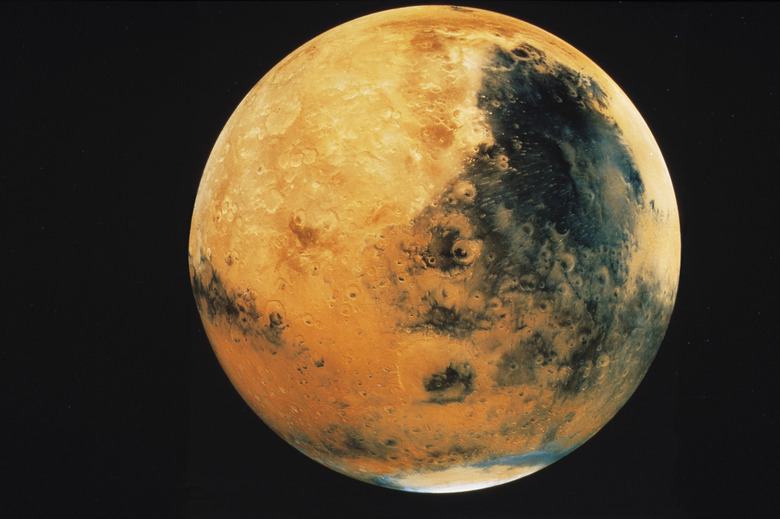The Average Wind Speed On Mars
Mars orbits beyond the Earth's trajectory, making it the fourth planet from the sun. Mars has a much thinner atmosphere than Earth, but the Red Planet's lower gravity allows for planet-wide weather phenomena. The winds on Mars can produce dramatic dust storms, with the dust taking months to dissipate.
The Atmosphere of Mars
The Atmosphere of Mars
To understand the winds of Mars, you have to understand the planet's atmosphere. The surface temperature varies from minus 87 to minus 5 degrees Celsius (minus 125 to 23 degrees Fahrenheit). The atmosphere is mostly a mixture of carbon dioxide, nitrogen and argon, with traces of other gases. The surface pressure is very low, as Mars has a very thin atmosphere. Earth has an average air pressure of 1,013 millibars, or 29.92 inches of mercury, more than a hundred times that of Mars, at 7.5 millibars or 0.224 inches of mercury.
Viking Site Measurements
Viking Site Measurements
The sites of the Viking landers are some of the best-studied regions on Mars. Like the wind speeds of Earth, the average Martian wind speeds varied by season. At the Viking sites, the average wind speed registered at 2 to 7 meters per second (5 to 16 mph) during the Martian summer. During the fall, the average wind speed increased to 5 to 10 meters per second (11 to 22 mph). Across the year, the wind speed on Mars averaged 10 meters per second (or 22 mph).
Max
Max
The low gravity of Mars allows for much greater wind speeds at times. Under the right weather conditions, the wind speed on Mars can reach up to 17 to 30 meters per second. The maximum speed of 30 meters per second (60 mph) was observed during a dust storm at the Viking site.
Dust Storms
Dust Storms
Mars has some of the most dramatic dust storms of any planet in the solar system. The low gravity on Mars promotes much more powerful dust storms than those seen on Earth. Those on Mars are a vast, planet-wide phenomena. When the dust storms on Mars begin, they can envelope the planet's hemispheres for years at a time, creating a challenge for exploration.
Cite This Article
MLA
Boumis, Robert. "The Average Wind Speed On Mars" sciencing.com, https://www.sciencing.com/average-wind-speed-mars-3805/. 24 April 2017.
APA
Boumis, Robert. (2017, April 24). The Average Wind Speed On Mars. sciencing.com. Retrieved from https://www.sciencing.com/average-wind-speed-mars-3805/
Chicago
Boumis, Robert. The Average Wind Speed On Mars last modified March 24, 2022. https://www.sciencing.com/average-wind-speed-mars-3805/
